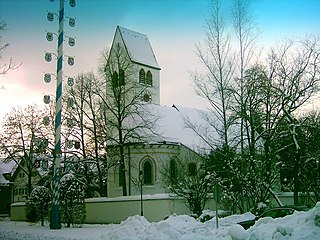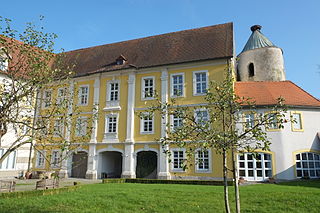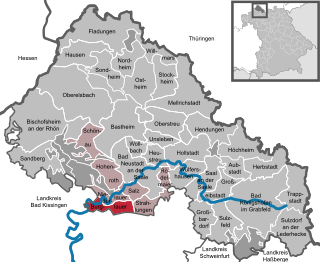
Altenstadt an der Waldnaab is a municipality in the district of Neustadt an der Waldnaab in Bavaria, Germany. It is situated on the river Waldnaab, 2 km (1.2 mi) southeast of Neustadt an der Waldnaab, and 5 km (3.1 mi) north of Weiden in der Oberpfalz. Bundesautobahn 93 passes west of Altenstadt. It has a railway station on the Weiden–Oberkotzau railway.

Greifenberg is a municipality in the district of Landsberg in Bavaria in Germany.

Bruckmühl is a market town in the district of Rosenheim, in Bavaria, Germany. It is situated on the river Mangfall, 16 km west of Rosenheim.

Gräfelfing is a municipality in the district of Munich, in Bavaria, Germany. It is located 1 km west of Munich.

Ergolding is a municipality in the district of Landshut, in Bavaria, Germany. It is situated on the left bank of the Isar, 5 km northeast of Landshut.

Iphofen is a town in the district of Kitzingen in Bavaria, Germany. It has a population of around 4,500. Iphofen is known for its rare complete medieval town wall and other historic buildings as well as for being a location of wine production.

Thannhausen is a town in the district of Günzburg, in Bavaria, Germany. It is situated on the river Mindel, 24 kilometres (15 mi) southeast of Günzburg, and 33 kilometres (21 mi) west of Augsburg.

Eggolsheim is a municipality in the district of Forchheim in Bavaria in Germany.

Wörnitz is a municipality in the district of Ansbach, in Bavaria, Germany. It is situated on the river Wörnitz, west of Ansbach.

Bechhofen is a market town and municipality in the district of Ansbach in Bavaria in Germany.

Dürrwangen is a municipality in the district of Ansbach in Bavaria in Germany.

Mönchsroth is a municipality in the district of Ansbach in Bavaria in Germany.

Ohrenbach is a municipality in the district of Ansbach in Bavaria in Germany.

Bischofswiesen is a municipality in the district of Berchtesgadener Land in Bavaria in Germany.

Heroldsbach is a municipality in the district of Forchheim in Bavaria in Germany.

Leuchtenberg is a municipality in the district of Neustadt an der Waldnaab in Bavaria, Germany, essentially a suburb of nearby Weiden in der Oberpfalz, and a larger historical region in the Holy Roman Empire governed by the Landgraves of Leuchtenberg.

Fischen im Allgäu is a municipality in the district of Oberallgäu in Bavaria in Germany.

Beratzhausen is a market town and municipality in the district of Regensburg in Bavaria in Germany.

Burglauer is a municipality in the district of Rhön-Grabfeld in Bavaria, Germany. It lies on the river Lauer.

Brannenburg is a municipality in the district of Rosenheim in Bavaria in Germany. There is a railway station located in Brannenburg.

























